In this issue’s report Colin Wheeler covers RAIB’s annual report for 2020, the retirement of Simon French, accidents, near misses, no more lows and how post covid working should become safer.
Gratitude and regret are amongst my emotions having learnt of Simon French’s planned retirement this Autumn from the job of Chief Inspector of the Rail Accident Investigation Branch (RAIB). They recently published their annual report for 2020 (January 1 to December 31). Simon has drawn attention to the fact that October 17 last year was the fifteenth annual anniversary of the start of RAIB’s investigations.
Over the years they have published 368 reports and 102 safety digests. Simon’s commitment and understanding of the personal loyalty of railway people and what may be described as the railway family has been evident during his time as Chief Inspector. It is reflected in the 2020 Annual Report which is comprehensive, well-illustrated with hard hitting pictures and without excessive or repetitive pie charts and tables.
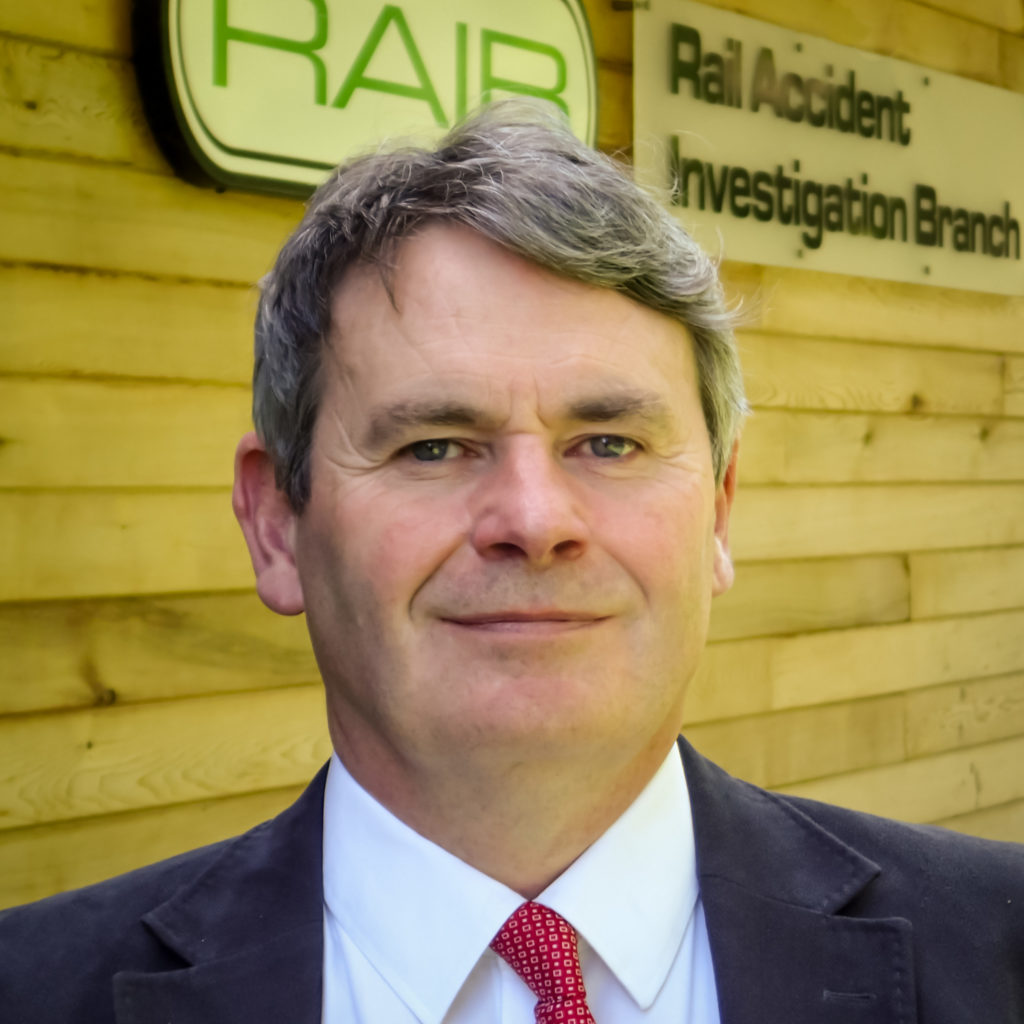
Summaries of Learning, urgent safety advice and 61 recommendations
One of RAIB’s initiatives of which Simon and his team should be proud is the publication of “Summaries of Learning”. This series of reports began last year with the publication of one covering “the safe management of weather-related events which affect train operation” and another on “the integrity of train braking systems”.
In 2020 RAIB received an astonishing 457 notifications leading to 38 preliminary examinations of evidence. These resulted in the publication of 14 detailed reports and 6 safety digests. As a result, four letters were sent to Coroners and two “Urgent Safety Advice” notifications were circulated.
Also, during the year RAIB made 61 safety recommendations whilst keeping a check on outstanding ones. Investigations are followed by consultation with those involved prior to their publication. Nonetheless, the average time taken to investigate and publish is now down to eleven months.
Simon French comments that “the rail industry is one of the most open sectors of the UK economy on matters relating to safety” and adds “the entire industry benefits from learning from accidents, regardless of which companies were involved”.
Without doubt Simon’s contribution to railway safety has been significant with a number of class investigations providing deeper insights into areas for improvement.
But there is still a long way to go and it seems likely that his successor will be kept busy. My hope is for a safer railway for all who work or travel on our railways. Being an eternal optimist, I should like to see safety improve to such an extent that RAIB needs fewer investigators.
I recently exchanged emails with a former colleague related to how and when our main line railway will at last stop using people holding coloured flags to stare into the distance, concentrate and blow horns or whistles to warn of approaching trains, including those travelling at 125 mph!
An aspiration which I hope will be realised by the efforts of Network Rail’s Safety Task Force from whom I hope we will learn more at this year’s Safety Summit.
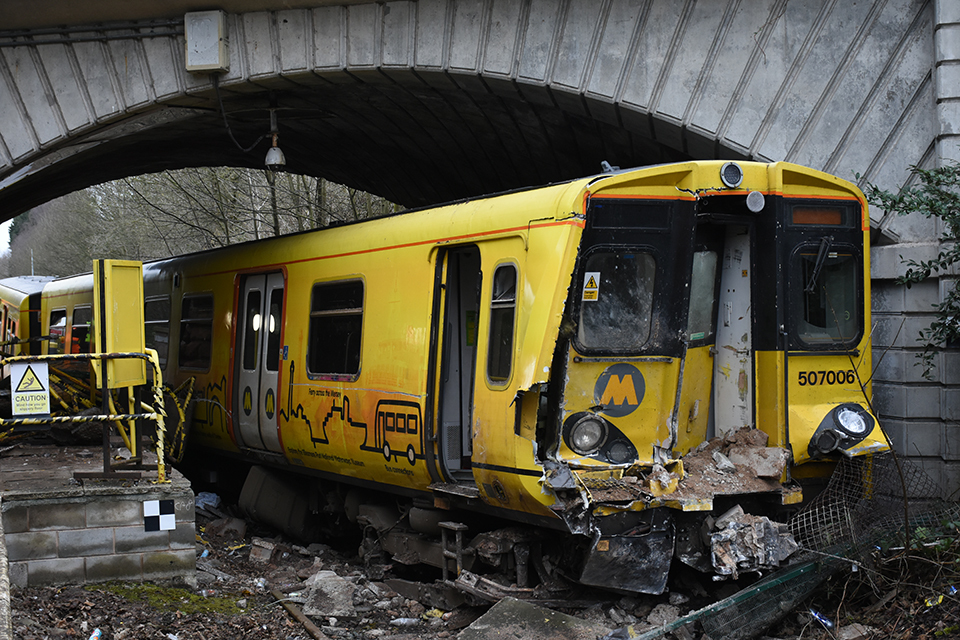
Near miss with Trackworker in a tunnel
Currently RAIB are continuing their investigation of a near miss with a track worker in Llangedai Tunnel at around 1232 on February 13th. The worker was inspecting and removing icicles in the tunnel when he was involved in a near miss with a passenger train travelling at 72 mph. There were no injuries; RAIB will issue a Safety Digest.
Track damage between Pencoed and Llanharan South Wales
RAIB are investigating how at around 0210 hours on March 6th a 2125 freight train from Robeston (Milford Haven) to Theale broke two rails and caused track damage. The train was stopped beyond Cardiff Central Station by a call from the signaller to the driver informing him of a problem.
The driver was instructed to travel over the impact load detection system at Marshfield to confirm suspicions that wheel flats had caused track damage. No problem was highlighted so the train was allowed to continue. It was finally stopped at in the Horfield Junction area, near Bristol after a report of unusual noises was made by staff at Stoke Gifford Maintenance Depot.
The train consisted of a locomotive and 23 petroleum product loaded tank wagons. Part of the brake rigging on the lead bogie of the 11th wagon had become detached and the trailing wheels on that bogie had significant damage (wheel flats). Some braking components were missing. On examination other wagons showed wheel tread damage, possibly consistent with their wheels having stopped rotating at other times during the journey.
Wheel flats broke rails
RAIB’s preliminary examination showed that the brakes were properly released when the train left Robeston, but some wheel sets ceased to rotate at some point, so wheel flats developed but some later began to turn again, possibly after a change of driver at Margam.
Impact loading from the rotating damaged wheels, particularly those on the 11th wagon gave rise to the broken rails and caused the damage to the brake rigging. RAIB are looking to see if there are similarities with the Marlais Junction derailment of August last year.
Collision with buffer stop at Kirkby Station, Merseyside
On March 13th this year at around 1853 the 1835 Liverpool Central to Kirkby passenger train ran into the buffers at the end of the Merseyrail Northern line platform at Kirkby. The train approached the station at 42 mph before an emergency brake application was made.
It hit the buffers, derailed and collided with the platform extension which links the Northern line platform to the adjoining Kirkby Branch line one. The derailed train came to a stop under a bridge and clear of the Branch Line which was not occupied by a train at the time. Twelve people suffered minor injuries but significant damage was caused to the train and railway infrastructure.
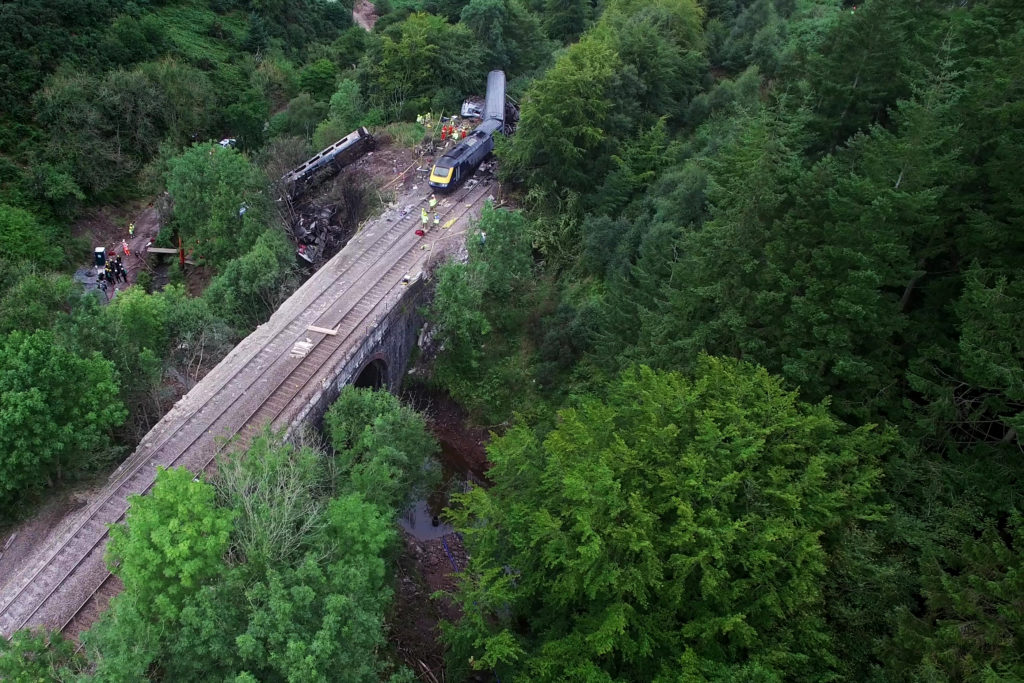
Carmont Aberdeenshire interim investigation report
On April 19th RAIB published an interim report on the Carmont Aberdeenshire fatal accident that occurred on August 12th last year. Three people died and six were injured when the train ran into debris washed onto the track at around 0937. Carmont is between Laurencekirk and Stonehaven on the two-track railway route from Montrose to Aberdeen.
A mile and a half north east of Carmont Signal Box the railway is carried by a single span masonry arch bridge above Carron Water. Approaching the bridge, the railway is on the side of the steeply sloping river valley in a cutting which ends about 50 metres from the bridge. The railway then runs on an embankment before crossing the bridge.
New drain and catchpits
Heavy and locally intense rain fell on August 11th reaching Carmont at around 0550 and continuing until 0900 when the sun began to shine as the train approached the site. In total about two inches of rain fell.
In 2009 the instability of the cutting face resulted in Network Rail instructing Carillion to “undertake improvement works”. Ove Arup designed a system to secure the slopes both sides using rockfall netting, and a new drain as the existing one was not effective. The new drain followed the crest of the slope at a gentle gradient until it reached the end of the cutting from where it steepened to 1 in 3. Catchpits were installed for maintenance and inspection.
Inspections carried out
The interim report lists inspections carried out in January 2017, 14th June 2020 and overnight by a technician on 11th/12th August. Although the crest drain system was completed in 2012, only the section closest to the track from catchpit 18 to the outfall was listed on Network Rail’s drain maintenance database. The investigators found no evidence of the drain upslope of catchpit 18 being inspected since its construction. On May 13th 2020 two Network Rail staff from Perth using a loaded handheld computer from the database carried out an inspection but it did not include the crest drain upslope of catchpit 18. Their downslope inspection did not reveal any faults.
Scour protection works were being carried out at the base of the bridge over which the derailed train travelled on August 12th.
Landslip reported
That morning southbound departures from Aberdeen at 0506 and 0536 passed through Carmont without incident but the 0546 to Edinburgh was cancelled due to “heavy flooding”. The train in the accident was the 0638 Aberdeen to Glasgow Queen Street which had passed Carmont Signal Box before it was stopped by the signaller using GSM-R radio due to the reporting of a landslip. It stopped 570 metres before the landslip and returned north.
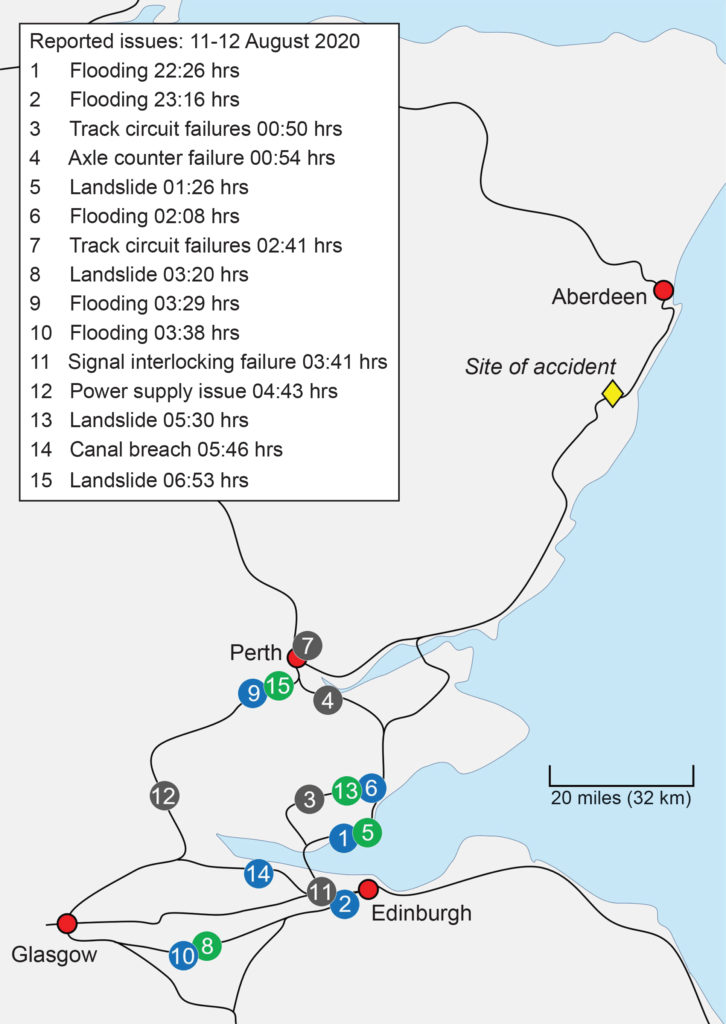
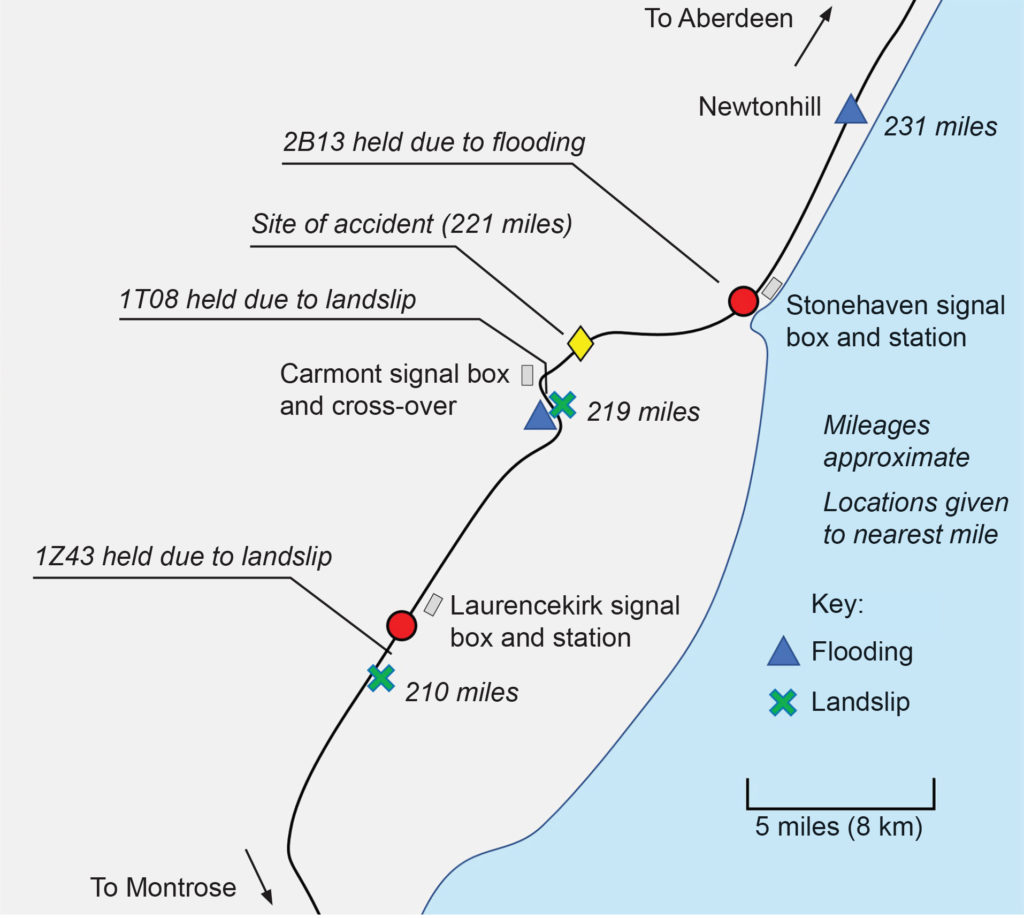
Control decided the train should return to Stonehaven to avoid the possibility of passengers becoming stranded. It was 0917 before the necessary clamps and scotches had been fitted and the train was then authorised to crossover and return north via Carmont to Stonehaven.
Train travelling at 73 mph
The train was travelling at 73 mph when it entered a left-hand curve restricting the driver’s view of the washout debris until he was just 120 metres from it. The (On Train Data Recorder) OTDR showed an emergency brake application, but this would have had little significant effect before the train hit the debris. The leading power car derailed to the left and ran for 60 metres until it struck a section of bridge parapet. It destroyed more than half of the parapet before falling from the bridge. The driver’s cab became detached on impact with the ground.
The interim report says, “investigation of the land above the railway is continuing and monitoring equipment is continuing to provide data on ground conditions and water flows”. The cause was “colliding with stones washed out from the gravel filled crest drain and adjacent ground”. RAIB is continuing to investigate whether other factors such as the drainage systems design or the quality of installation, contributed to the displacement of material.
Drainage inspections
Tellingly it adds “The lack of an effective drainage inspection regime meant that any indications of problems upslope of catchpit 18 would not have been detected”. RAIB’s ongoing investigations relate to severe weather including the management of storms, Carmont drainage system design, construction and inspection processes, and in respect of the train, the mitigation of derailments.
The Office of Rail and Road (ORR) are also involved with Scotland’s Lord Advocate having instructed BT Police, Police Scotland, and the ORR as the industry regulator to carry out an independent joint investigation.
Annual Report for 2020
RAIB’s annual report for 2020 refers to three fatal accidents being investigated in addition to Carmont. Simon French, “is saddened by the February 2021 trackworker death at Surbiton which is subject to a thorough RAIB investigation”. Referring to the two deaths at Margam (July 2019) he reminds readers that the identified underlying factors were safe work planning, monitoring and supervision, behaviours/leadership, corporate culture and change management.
Safety of Track Workers
In the report Simon French comments that, “the areas that need to be addressed to improve the safety of trackworkers have been repeatedly highlighted in 44 investigations by RAIB in the last 14 years”. He acknowledges the efforts made and commitment of both the ORR and Network Rail’s well-funded Safety Task Force. Referring to depots and sidings he adds that “organisations operating trains and those maintaining them were not working well together”.
New, Network Rail trackworker safety commitment
NRA 21-06 was published on Network Rail’s Safety Central website on April 14th heralding the overdue decision to phase out the use LOWS (Lookout Operated Warning Systems). The written commitment is that Network Rail “will replace LOWS with semi-automatic and automatic track warning systems”. The ORR Improvement Notice requiring the “removal of unassisted lookout working” stipulated compliance by July 2022 but in a letter to contractors and suppliers of services dated 28th May Network Rail is now expecting compliance one year earlier in July this year. When this White Zone working is achieved it will be a lasting testament to the efforts made by the retiring Chief Inspector of the RAIB.
The published Network Rail safety advice says that “in the last twelve months unassisted lookout warning has been reduced by over 70% and near misses by 50% but near misses using LOWS have worsened.” It adds that “investigations found that the equipment worked as designed, the causes were linked to human error”. Many railway people now long retired will regret the delay of around 20 years in the making of this commitment but now is a good time given the anticipated evolution of railways post Covid!!
How quickly this has been done I suggest will be a hot topic for this year’s Rail Media Safety Summit in September!
Post Covid railway working, organisation and safety
The Williams-Shapps Review of Railways was delayed even before the pandemic. My view is that morning and evening commuting travel will remain at lower levels as many businesses will retain varying degrees of working from home as the norm. There may be an effect on central city office occupancy. Already there is a shift towards developing new and enhancing existing railways in northern cities and country parts of Britain and an overdue reduction in focussing so much on London’s aspirations. Global warming may well lead to a rebalancing of train propulsion methods and more localised political control has been discussed. From a trackworker safety viewpoint, Network Rail is already talking about moving away from using nights and weekends to carry out renewal, project and maintenance work. A steadier work stream could reduce costs, provide full time employment and result in safer working!
Just maybe, Simon French’s successor will have a less demanding job working with the new Great British Railways organisation!
RRV electrification collision at Ramsden Bellhouse
RAIB news story issued on May 14th refers to an accident that happened around 0700 hours on the morning of May 2nd. On a worksite between Billericay and Wickford in Essex two road/rail vehicles collided, the two workers travelling in the basket at the end of their night shift were injured, one seriously. They were hit by a 360-degree crane jib of the machine travelling behind them. The work was the renewal of overhead electrification equipment. RAIB says they will consider “safe worksite travel, hours on duty, and other factors.” I am reminded of comments in report 08/2020 on a collision between mobile elevated work platforms at Rochford (January 25th 2020). That report identified a “culture of getting the job done, disrespect and poor working relationships”.

